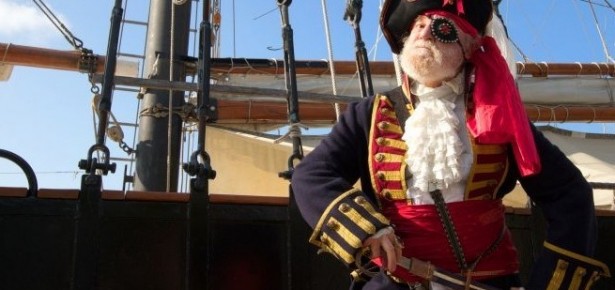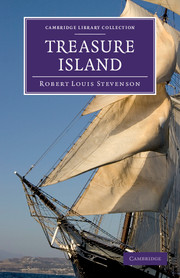
The history of pirates stretches far back – from the coastline of the Mediterranean; to China in the mid-16th Century; and right back into ancient Greece. Pirates have been feared at sea and the waterline for centuries.
In their long history, it’s inevitable that they have impacted on our society – documented in a range of romanticised fiction, and non-fiction titles. So, as a nod to today’s International Talk Like A Pirate Day, here’s our five books to help you find out more about their origins.
 Of course, this couldn’t be a list of pirate books without Robert Louis Stevenson‘s Treasure Island.
Of course, this couldn’t be a list of pirate books without Robert Louis Stevenson‘s Treasure Island.
It was largely ignored when it first appeared as a serial between 1881-1882 in the children’s magazine ‘Young Folks’, but after publication as a book in 1883, it sailed off to success, and has continued to shape the depiction of pirates in countless films, cartoons, television productions, and fancy dress parties.
There are few who haven’t heard of Long John Silver and the intrepid Jim Hawkins, and fewer still who won’t recognise the depiction of pirates that Stevenson’s legacy has left us – eye patch, wooden-leg, blazing cutlass, bushy beard, and a penchant for gold.
In the trailer for Disney’s first ever live-action film – Treasure Island (1950) – the pirates do seem to retain a marauding reputation, with wild tempers and loyalties that change as frequent as the winds they sail into. More recently, the image of the pirate has become more loveable by the time we get to Hook with Dustin Hoffman and Robin Williams (1991), and, again via Disney, The Pirates Of The Caribbean film series starring Johnny Depp.
Stevenson’s book does manage to reference some historical pirates along the way though – with mentions including Blackbeard and William Kidd – both notorious in the late 17th and early 18th Centuries.
With the ultimate in pirate fiction covered, let’s take a look at how history recalls them in these four non-fiction titles:
Matt K Matsuda, author of ‘Pacific Worlds: A History of Seas, Peoples, and Cultures’ (2012)’ dedicates an entire chapter (8) to ‘Pirates and Raiders of the Eastern Seas’. His opening paragraph pretty much sets the scene for how real pirates have been documented over the centuries:
“Scrolls and paintings from the sixteenth century show them coming. Along the China coast, the seaborne gangs were marauders, murderers, kidnappers, and extortionists, terrorising villages, stealing children and women. Accounts indicate that they arrived in swarms of boats as raiding parties numbering hundreds as they struck along coastal settlements, burning and pillaging. Storehouses were looted, farmers murdered, graves robbed. Victims were tortured, scalded, and disembowelled, sometimes for entertainment”
Matsuda goes on to explain that whilst the pirates of the eastern seas tended to operate outside of law, there were also some that collaborated with empires to help defeat enemies or to disrupt trade routes. Being a 16th Century pirate would probably have taken you to places including China, the Philippines, and Taiwan, and seen you challenge forces from Asia and Europe alongside fantastically and most memorably named swashbucklers such as Iron Zhanghong, and Deep Mountain Monkey (yes, really).
You can read more from Matsuda’s Pacific Worlds via our ‘Look Inside’.
 Philip de Souza‘s ‘Piracy in the Graeco-Roman World‘ (1999) is an historical study of piracy from the Archaic period to Late Antiquity. It looks at the exploits of pirates in the ancient world by referring to the works of, amongst others, Homer and Cicero.
Philip de Souza‘s ‘Piracy in the Graeco-Roman World‘ (1999) is an historical study of piracy from the Archaic period to Late Antiquity. It looks at the exploits of pirates in the ancient world by referring to the works of, amongst others, Homer and Cicero.
Reaching far back, including Thucydides recounting Minos as clearing the seas of piracy in order to improve his income, de Souza also reveals the early references by Homer of groups of people labelled pirates. The relationship between warfare and piracy, and the claims of various rulers of their (often over-exaggerated) actions to suppress these undesirable gangs, are also widely covered.
The book also explores the increase of pirates in Roman literature during the first four centuries AD, when real-life pirates were in decline, and suggests that the ‘development of the dangerous and romantic pirate, a figure familiar to modern readers from countless books and films, could probably have occurred only in the Roman Peace’.
 Miles Ogborn‘s textbook Global Lives: Britain and the World 1550-1800 (2008) explores the impact of Caribbean pirates on shipping and economics, and politics. He covers the evolution of trade organisations, and their need to build fortifications and arm their soldiers and ships along key trade routes in a bid to deter or defeat pirate attacks, when mutinies were commonplace:
Miles Ogborn‘s textbook Global Lives: Britain and the World 1550-1800 (2008) explores the impact of Caribbean pirates on shipping and economics, and politics. He covers the evolution of trade organisations, and their need to build fortifications and arm their soldiers and ships along key trade routes in a bid to deter or defeat pirate attacks, when mutinies were commonplace:
“Pirates knew their prey. Pirate crews were formed and increased through mutinies on merchant ships, and especially when pirates captured a likely vessel. The sailors on board the captured ship would be given the choice to join the pirates or fend for themselves. They had to make a careful calculation of what sort of choice this was, and what the implications were of choosing either way. Which would lead to an easier life, which to death?”
In Marcus Rediker‘s book Between the Devil and the Deep Blue Sea (1989), he looks at the social and cultural dimensions, activities, and hierarchy of Anglo-American pirates (one source goes on to estimate that there were 5,000 pirates to the Royal Navy’s 13,000 crew in the early 1710’s), and the activities of trade organisations and the Royal Navy to eradicate them.
Take note, wannabe pirate – he also explores reasons behind the decline of pirates in the 18th century:
“Pirates themselves unwittingly took a hand in their own destruction. From the outset, theirs had been a fragile social world. They produced nothing and had no secure place in the economic order. They had no nation, no home; they were widely dispersed; their community had virtually no geographic boundaries. Try as they might, they were unable to create reliable mechanisms through which they could either replenish their ranks or mobilize their collective strength. These deficiencies of social organization made them, in the long run, relatively easy prey”.
You can view a preview of the book over at Google Books.
If the five books above aren’t enough to persuade you from a life of treachery upon the seas, and you’re still hungry for more International Talk Like A Pirate Day treasure, check out Twitter, which is a-wash with swashbuckling pirates today via the #ITLAPD or #PirateDay hashtags. If you’re a user of Facebook, then you could always switch your language version to ‘English (Pirate)’, and you can even Google in Pirate too.
Now, be gone with you landlubber, before i make thee walk the plank! Arr-ha!
Latest Comments
Have your say!